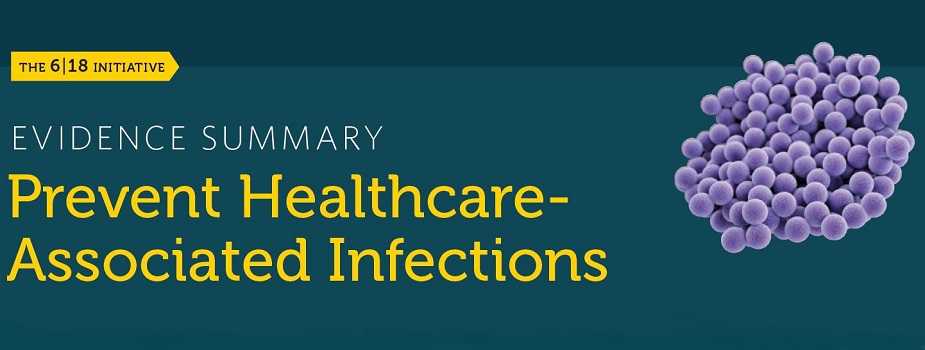Evidence Summary: Prevent Healthcare-Associated Infections

Payer Interventions
Proposed Payer Intervention
- Require antibiotic stewardship programs in all hospitals and skilled nursing facilities.
Opportunities for Payers and Providers
Continue work with CMS to expand conditions of participation to assure antibiotic stewardship programs in a broader range of health care settings.
Key Health and Cost Evidence Messages for Payers and Providers
Payers can promote the adoption of antibiotic guidelines that restrict widespread broad-spectrum use. Pharmacists and infectious disease staff can recommend discontinuing antibiotics or provide alternatives to prescribers. This can decrease antibiotic resistance and significantly reduce deadly diarrheal infections.
Who’s at Risk?
At least 2 million illnesses and 23,000 deaths can be attributed each year to antibiotic-resistant infections. Nearly 900,000 cases of antibiotic-resistant infections were reported in 2010. Preliminary 2014 data suggest more than 40% of U.S. acute care hospitals have antibiotic stewardship programs that incorporate the CDC Core Elements for Hospital Antibiotic Stewardship Programs.1
Current Payer Coverage (as of August 2015)
Medicare
- Proposed revision of Conditions of Participation to require antibiotic stewardship programs for long-term care and acute care settings aligning with CDC’s Core Elements of Antibiotic Stewardship Programs.
Medicaid
- Proposed revision of Conditions of Participation to require antibiotic stewardship programs for long-term care and acute care settings aligning with CDC’s Core Elements of Antibiotic Stewardship Programs.
Commercial/Private
- Not required.
- Anthem, Blue Cross (CA): Quality-In-Sights®, Hospital Incentive Program (Q-HIP®), national hospital quality and value-based payment initiative, intended rollout in 2016.
Supporting Health and Cost Evidence: Science Behind the Issue
A study implementing the CDC Antibiotic Stewardship Guidelines resulted in 25% of antimicrobial orders being modified (86% resulted in less-expensive therapy, and 47% resulted in use of a drug with a narrower spectrum of activity), significantly increasing microbiologically based prescribing (63% vs. 27%). Stepwise implementation of an antimicrobial stewardship program demonstrated progressive decreases in antimicrobial consumption and savings of $913,236 over 18 months.2
A study of an intervention that led Canadian medical trainees to implement CDC-recommended antibiotic “time outs” reduced antibiotic costs on the unit from $149,743 (Canadian dollars) (January 2011 to January 2012) to $80,319 (January 2012 to January 2013), for a savings of $69,424 (46% reduction).3
A pharmacist records review of inpatients who were prescribed two or more antibiotics in order to identify redundant combinations identified 70% of combinations investigated were inappropriate. The pharmacist-stewardship intervention was projected to have saved $10,800 and 584 days of reduction in antibiotic combination days.4
References
1 CDC. Core Elements of Hospital Antibiotic Stewardship Programs. Atlanta, GA: US Department of Health and Human Services, CDC; 2014.
2 Dellit, TH, Owens RC, McGowan JE, Gerding DN, Weinstein RA, Burke JP, et al. Infectious Diseases Society of America and the Society for Healthcare Epidemiology/Burden of America Guidelines for Developing an Institutional Program to Enhance Antimicrobial Stewardship. Clinical Infectious Diseases. 2007;44(2):159–77. doi: 10.1086/510393.
3 Lee TC, Frenette C, Jayaraman D, Green L, Pilote L. Antibiotic self-stewardship: trainee-led structured antibiotic time-outs to improve antimicrobial use. Ann Intern Med. 2014 Nov 18;161(10 Suppl):S53-8. doi: 10.7326/M13-3016
4 Glowacki RC, Schwartz DN, Itokazu GS, Wisniewski MF, Kieszkowski P, Weinstein RA. Antibiotic combinations with redundant antimicrobial spectra: clinical epidemiology and pilot intervention of computer-assisted surveillance. Clinical Infectious Diseases. 2003;37(1):59–64.
- Page last reviewed: November 30, 2016
- Page last updated: November 30, 2016
- Content source:


 ShareCompartir
ShareCompartir
